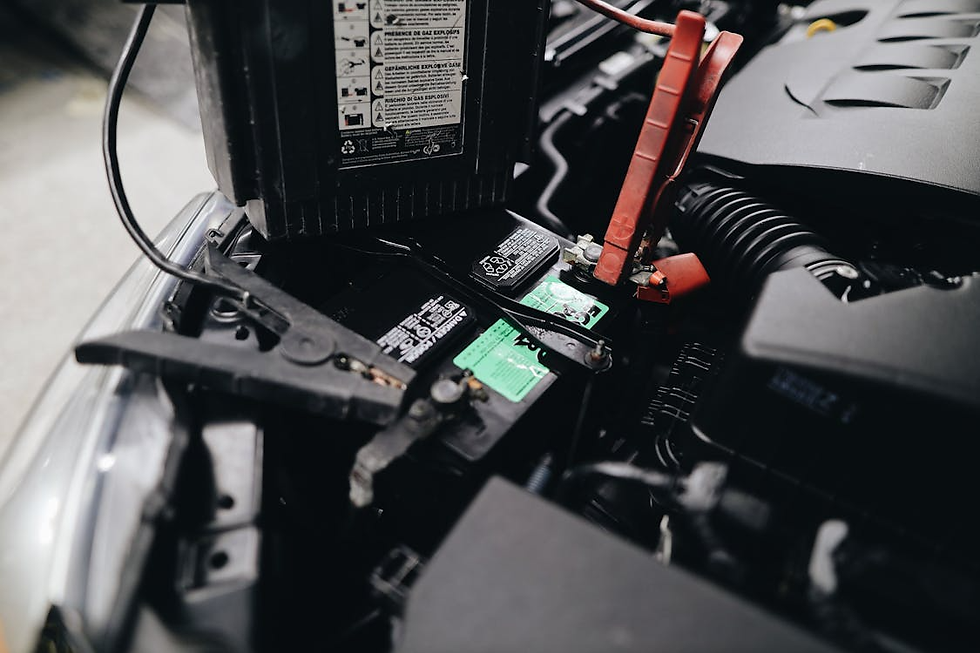Is It the Battery or the Alternator? How to Tell the Difference
- web service
- 10 hours ago
- 4 min read
When your car refuses to start or you experience unexpected electrical issues on the road, it's easy to assume the battery is to blame. But what if the real culprit is your alternator? Both components are essential to your vehicle’s electrical system, and when one fails, the other often takes the heat. Knowing how to tell the difference between battery vs alternator issues can save you time, money, and frustration.
The Role of the Battery in Your Vehicle
Your car's battery is responsible for providing the initial power needed to start the engine. It also powers electronic components such as lights, radio, and dashboard controls when the engine is off. In short, the battery gives your vehicle life at ignition.
A typical car battery lasts about 3 to 5 years, depending on weather conditions, usage, and maintenance. Once it reaches the end of its lifespan or is drained by lights left on or parasitic drains, it will no longer hold enough charge to crank the engine.
The Role of the Alternator in Your Vehicle
The alternator, on the other hand, is the part of the charging system that keeps the battery charged and powers your vehicle’s electronics while the engine is running. Once the car is started, the alternator takes over from the battery and supplies electricity to everything from your headlights to your power windows.
If your alternator fails, your battery will no longer receive a charge — meaning your vehicle will run until the battery is completely drained, then shut down. Alternators typically last 7 to 10 years or around 100,000 to 150,000 miles.
Battery vs Alternator: Key Symptoms
So how do you know which part is failing? Look out for these signs:
Signs of a Dying Battery
● Slow Engine Crank: If your engine turns over sluggishly when you try to start the car, the battery may not have enough juice.
● Dim Headlights (While Engine Is Off): Dim lights that brighten once the engine starts often point to a weak battery.
● Clicking Sound When Turning the Key: A telltale click (instead of the engine starting) suggests low battery voltage.
● Swollen Battery Case or Corrosion: A bloated battery case or crusty terminals are signs of battery aging or damage.
● Frequent Jump Starts Needed: If you're reaching for the jumper cables often, it’s likely the battery can’t hold a charge.
● Battery Warning Light: The battery light on your dashboard may indicate low voltage or battery failure.

Signs of a Failing Alternator
● Dim or Flickering Lights While Driving: The alternator powers headlights once the engine is running. Flickering or dimming while driving could mean it's failing.
● Dead Battery Soon After Replacement: If you’ve replaced your battery and it dies again quickly, the alternator may not be recharging it.
● Electrical Failures: Malfunctions in the radio, power windows, seat heaters, or dashboard lights may point to a power supply issue.
● Battery or ALT Light on Dashboard: Some vehicles show a battery symbol even for alternator issues. Others have a specific “ALT” warning.
● Whining or Grinding Noise: A worn alternator bearing can create unusual noises while the engine runs.
● Burning Rubber Smell: If the alternator pulley is misaligned or the belt is slipping, it can create a burning smell due to friction.
Simple Diagnostic Tests You Can Try
Here are a few easy ways to narrow it down before heading to a shop:
1. The Headlight Test
Turn on your headlights with the engine off. If they are dim, start the engine. If they brighten significantly, your battery is likely the issue. If they remain dim or flicker while the engine is running, your alternator may be struggling.
2. The Jump-Start Test
Try jump-starting your car. If it starts but then stalls soon after removing the cables, the alternator is probably not charging the battery.
3. Use a Multimeter
A voltage test can be very telling:
● A fully charged battery should read around 12.6 volts when the engine is off.
● When the engine is running, the voltage should rise to 13.7–14.7 volts.
● If the voltage doesn't rise when the engine is running, your alternator may not be working properly.

Can Both Fail at Once?
Unfortunately, yes. A bad alternator can kill a new battery by not charging it correctly. Similarly, a weak battery can strain the alternator, causing premature wear. That’s why professional testing is always recommended when dealing with repeated power issues.
When to Seek Professional Help
If your vehicle is experiencing any of the above symptoms and you’re not sure whether it’s a battery vs alternator issue, your best move is to let a certified technician inspect the system. Ignoring the warning signs could leave you stranded — or cause more costly damage down the road.
Trust Platinum Wrench Auto Repair for Electrical Diagnostics
When your car gives you trouble, you need answers fast. At Platinum Wrench Auto Repair, our expert technicians use the latest diagnostic tools to determine exactly what’s wrong — whether it’s a dead battery, a failing alternator, or both. We’ll explain the issue clearly, offer honest recommendations, and get you back on the road safely and quickly.
Stop guessing and start driving with confidence. Call Platinum Wrench Auto Repair today to schedule your diagnostic check.




Comments